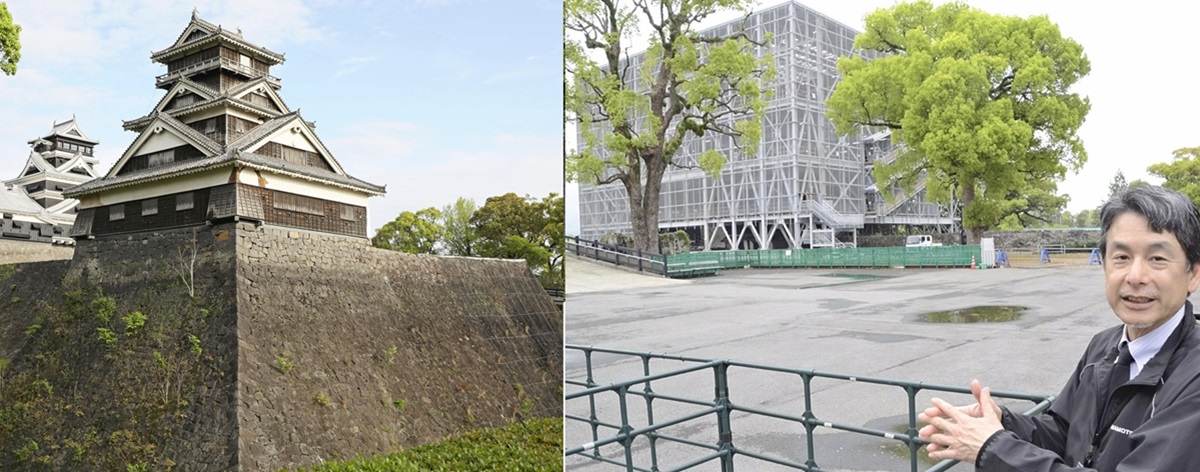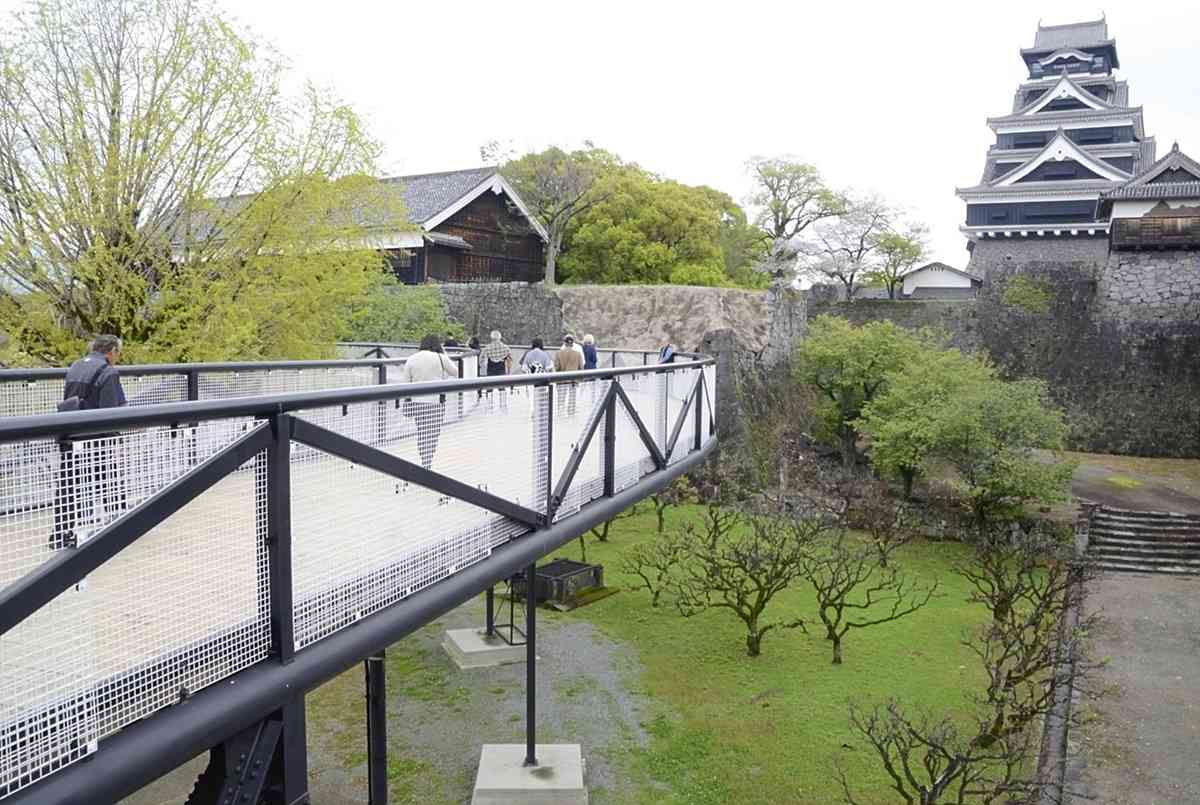Visitors look at Uto-Yagura, which still bears the scars of earthquake damage, on April 14 in Kumamoto.
12:42 JST, Apr 27, 2024
KUMAMOTO — Kumamoto Castle, which was severely damaged in the 2016 Kumamoto earthquake, is receiving more and more visitors thanks to its “visible restoration” that is expected to take decades.
In fiscal year 2023, the number of visitors reached 1.35 million people, about 350,000 more than the previous year, and recovered to almost 80% of pre-earthquake levels. Eight years after the earthquake that devastated the prefecture, an official involved in the restoration said: “We hope that people will remain interested in the region.”
The Kumamoto municipal government has started special openings of the castle’s Uto-Yagura Tower, which is still being restored, about once a month starting in April.

Left: The Uto-Yagura Tower before it was covered with scaffolding in 2021. Right: Yasuhiro Iwasa, an official from the Kumamoto Castle General Office Municipal Office, shows the Uto-Yagura Tower surrounded by scaffolding
Uto-Yagura has been designated a Nationally Important Cultural Property. It is said to have been built in the Keicho era (1596-1615), when Kumamoto Castle was originally built. The tower is also called the third keep of the castle, after the main tower and the attached smaller keep. Uto-Yagura is a five-storey above-ground building with a basement. It suffered damage in more than 40 locations in the earthquake, including broken pillars and damaged exterior walls. While the tower escaped total destruction, the entire structure was leaning.
Dismantling of the tower started in January and it is completely covered in scaffolding. The restoration work is expected to be completed in the 2032 financial year. The municipal government has started allowing visitors to the scaffolding on the second Sunday of every month. It can also be visited from May 3 to 5 during Golden Week.

“We hope visitors will look closely at things like the collapsed walls, cracked kawara tiles and the current state of the tower, which you can only now see,” said Yasuhiro Iwasa, the chief official in charge of the municipality’s restoration Kumamoto Castle. Office. “We will continue our efforts to increase people’s understanding of the recovery process, while reporting data on the damage caused.”
Only 20% restored
Thirteen structures of Kumamoto Castle are nationally important cultural properties and all were damaged or destroyed by the earthquake. Twenty structures, including the main castle, were reconstructed in later periods and were also affected by the earthquake. The castle’s stone walls are known for their “Mushagaeshi” (warrior-repellent) structure that gradually steepens higher up the walls. Nearly 10% of the walls, about 8,200 square meters, collapsed during the earthquake.
The repair work on the main castle was carried out first and completed in 2021 as a symbol of the restoration. However, the entire castle is not expected to be fully restored until the 2052 financial year, with just over 20% of the planned work completed by the end of March 2022.
As access to the castle is limited due to restoration work, a special observation trail has been created which has played an important role in the revival of tourism. The five to seven meter high elevated path was constructed in 2020, allowing visitors to observe conditions up close without interrupting restoration work or blocking construction vehicles.

The special observation path from which visitors can see access-restricted areas in Kumamoto on April 8
Construction of such a trail to enable tourism while continuing recovery was unprecedented in the country and was a difficult project, said Yuzuru Tsukagawa of Nihon Sekkei Inc.’s Kyushu branch. in Fukuoka, who was involved in the trail’s design.
Because valuable underground foundations were left at the castle, the ordinary pile construction method could not be used. By laying mesh on the ground and paving the ground with stones, Tsukagawa’s team built a concrete foundation on top. He adopted a special construction in which the path was supported by columns and determined the observation route of 350 meters, taking care to cut down as few trees as possible. According to Tsukagawa, the process was like threading a needle.
In the 2015 financial year, more than 1.77 million people visited castle areas for which entrance fees apply. Although this number decreased due to the earthquake and the COVID-19 pandemic, it has increased in recent years thanks to the completion of the special observation path and the opening of the main keep.

Yuzuru Tsukagawa will speak about the special observation path in Fukuoka on April 8.
“Kumamoto Castle has managed to open to the public during restoration work while taking measures to protect cultural properties and ensure the safety of visitors,” said Toshitaro Minomo, professor emeritus of landscape architecture at Tokyo University of Agriculture, who was involved in the composition of the castle’s restoration plan. “Many disaster-affected areas can draw on Kumamoto’s experience.”



